
- Offer Profile
-
Stirling Cryogenics is the international market leader in stand-alone cryogenic cooling systems. Located in the Netherlands in the town of Son, at the outskirts of Eindhoven. Originally founded by technology giant Philips more than 70 years ago and it has been the cornerstone of our cooling systems ever since.
We design, build and supply cryogenic solutions based on the (reversed) Stirling thermodynamic cycle with over 4,000 installations worldwide. The Stirling cryogenerator makes it possible for our systems to produce temperatures ranging from from 200 K (-73°C) down to 15 K (-258°C). With a Stirling Cryogenerator you’ve got your own reliable and efficient cold source!
Stirling Cryogenerators: The Core of Cryogenic Cooling Systems

-
Stirling Cryogenerators, also known as Cryocoolers or Stirling Process Coolers (SPCs), are based on the highly efficient reversed-Stirling thermodynamic cycle. These units are the fundamental components of all Stirling Cryogenics systems. With a heritage spanning over 70 years, we have designed and supplied more than 6,000 of these efficient cryogenic coolers worldwide, proving their reliability in a vast range of demanding operational environments from maritime to desert, mountaintop to underground, and industrial to laboratory.
Technical Features of Stirling Cryocoolers- Highest efficiency possible (through reversed Stirling Cycle technology) leading to low electricity consumption
- Fully automated and PLC controlled
- Process specific heat exchanger integrated in the cold head
- Flexible process integration
- Robust design with proven reliability: some Cryogenerators are over 40 years in operation
- All rotational and reciprocating seals work at ambient temperatures
- Maintenance friendly
- Annual inspection and cleaning can be done by customer’s engineer at site
- Worldwide service available; mostly with nearby local service engineer
- Various options available such as capacity control, ATEX, maritime version etc.
- Supply according to all applicable coding, power grid and requirements of the customers’ site.
LNG production plants

-
Stirling Cryogenics has designed an integrated gas purification & liquefaction plant together with sister company Hysytech Srl from Turin, Italy for micro scale LNG production.
The plants are of a modular design and can be supplied in the range of 1 – 30 ton/day with each Stirling module producing approximately 1 ton/day. There are several different designs for different feed gas compositions. Standard designs are available for:
- Biogas
- Biomethane
- Pipeline Natural Gas
With its in-house engineering department Stirling Cryogenics offers tailored designs as well for:
- Natural Gas from a well
- Associated Gas from oil drilling
- Landfill Gas
LNG BOG management systems
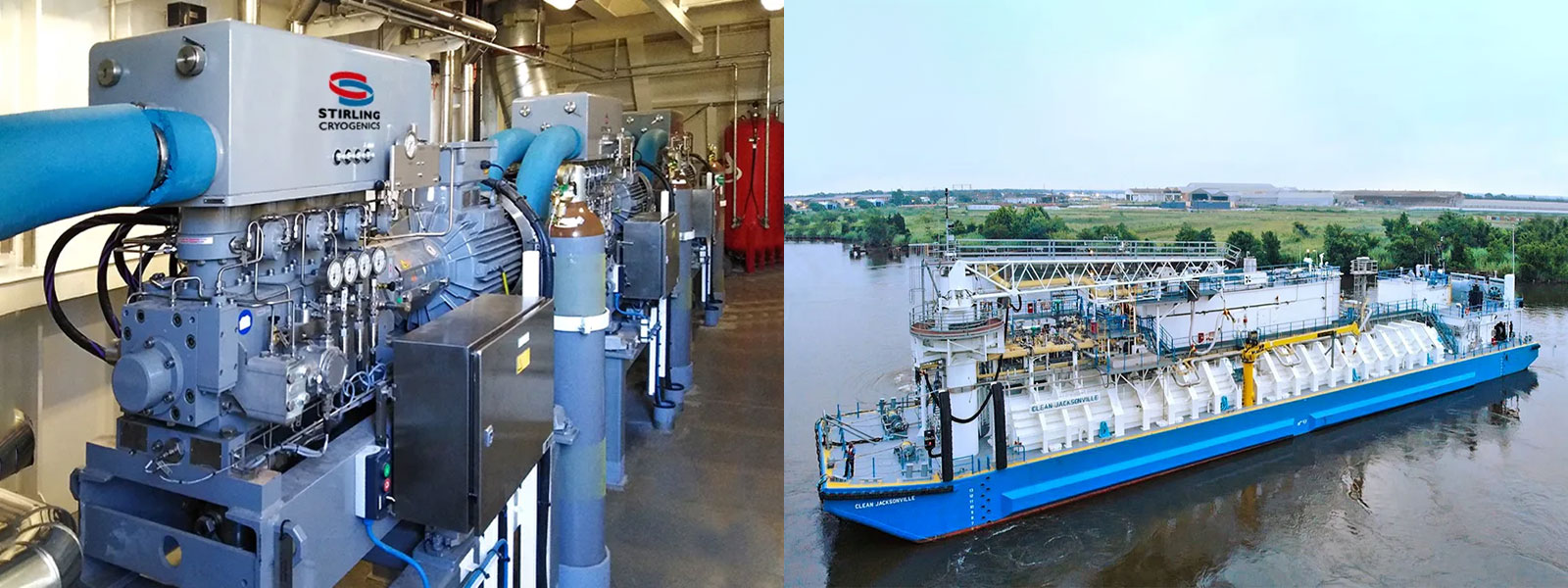
-
The StirLNG line of products is a range of SPC Cryogenerators that has specifically been modified for small (micro) scale Boil Off Gas Management by gas re-liquefaction or liquid subcooling. Each unit operates stand-alone, is driven by an electrical motor and has its own control unit. The StirLNG line offers BOG management in two different principles.
Gas re-liquefaction
Boil-off gas is taken from a storage tank, re-liquefied by the StirLNG and transferred back into the storage tank. This can be done by gravity or by using a separate transfer vessel.Methane feed gas specifications needed:
- Main stream CH4
- CxHy (C2 to C4) < 10%
- CxHy (C5+) < 1 ppm
- CO2 depending LNG conditions
- H2O < -70ºC dew point
- H2S < 3,3 ppm
- Oil content < 0,01 mg/m3
- Particles < 0,1 micron
- N2/O2 < 10%
Product specification:




StirLNG-1 Cryogenerator
-
The StirLNG-1 is our SPC-1 Cryogenerator specifically modified for small nano scale LNG production and re-liquefaction. Depending on the gas pressure, the StirLNG-1 can re-liquefy around 450 kg/day of LNG (340 gal/day).
The Stirling Cryogenerator operates stand-alone, driven by an electrical motor and has its own control unit. Boil-off gas can be taken from a storage tank, re-liquefied by the StirLNG cooler, and pushed back into the storage tank. As an alternative, liquid can be taken from the bottom of the storage tank, sub cooled and sprayed back in the tank, reducing the overall pressure of the system, eliminating boil off gas.




StirLNG-4 Cryogenerator
-
The StirLNG-4 is our SPC-4 Cryogenerator specifically modified for micro scale LNG re-liquefaction. Depending on the gas pressure, the StirLNG-4 can reliquefy around 1800 kg/day of LNG (1,8 metric tpd, 1350 gal/day).
The Stirling Cryogenerator operates stand-alone, driven by an electrical motor and has its own control unit. Boil-off gas can be taken from a storage tank, re-liquefied by the StirLNG and fed back into the storage tank. As an alternative, liquid can be taken from the bottom of the storage tank, sub cooled and sprayed back in the tank, reducing the overall pressure of the system, eliminating boil off gas.

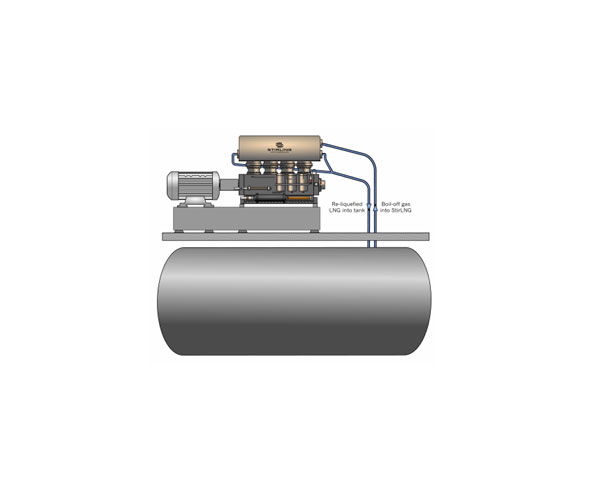


LNG conditioning with the StirLNG-4 Maritime
-
The StirLNG-4 is our SPC-4 Cryogenerator specifically modified for micro scale LNG re-liquefaction in maritime conditions. Depending on the gas pressure, the StirLNG-4 can re-liquefy around 1000-1800 kg/day of LNG (1,8 metric tpd, 1350 gal/day) per single unit (multiple units possible).
The Stirling Cryogenerator operates stand-alone, driven by an electrical motor and has its own control unit. Boil-off gas can be taken from a storage tank, re-liquefied by the StirLNG cooler, and back into the storage tank. As an alternative, liquid can be taken from the bottom of the storage tank, sub cooled and sprayed back in the tank, reducing the overall pressure of the system, eliminating boil off gas. For marine applications, e.g. on board LNG bunker vessels or vessels using LNG as fuel, the Stirling Cryogenics StirLNG cryogenerator can be certified, according the required class.
Liquid hydrogen plants

-
Stirling Cryogenerators have been widely used in the 1960’s and ‘70’s for the production of LH2 at various institutes and research laboratories all over the world. In material science small scale production was used to study the properties and behavior of LH2 and its effect on materials.
In scientific devices, the Stirling Cryogenerators have been used as LH2 re-liquefiers to create cold neutron sources and to run H2/D2 distillation columns. Today, some of these vintage machines are still in use, for instance the one at the National Institute of Cryogenic and Isotope Separation in Romania which was installed in 1973.
After the 1980’s, numerous systems have been supplied by Stirling Cryogenics using a cold helium loop for applications such as space chambers and LH2 cold neutron sources.
A recent project is the re-liquefaction system for the LH2 inventory of the cold neutron source at the Reactor Institute Delft of the Delft Technical university. For the RID, Stirling Cryogenics designed and built a system providing 900 W of cooling power at 20K, in a redundant set-up and with a variable heat load from 10 to 120%.
In the hydrogen market, Stirling offers two propositions:
- Liquid Hydrogen Production
- Liquid Hydrogen BOG management




Stirling Liquefaction of Hydrogen Systems
-
- The range of capacities we offer is from 5.5 up to 200 kg/day in one system, large capacities by multiple systems
- Smaller systems up to 44 kg/day can be placed in a plant room, but can also be offered as containerized system
- Larger systems are offered containerized as standard
- To allow for future growth, systems can be supplied for current size but already built for future extension, allowing later addition of Cryogenerators and hence capacity extension
- Cryogenerators can be stopped and started regularly, allowing to stop part of them in case less GH2 is available with less wind power. With increasing GH2 production, more Cryogenerators are started.
- Cool-down time to liquefaction from warm start is 20 minutes, shorter after short stops
- In smaller systems, liquefaction capacity can be varied by rpm depending GH2 supply
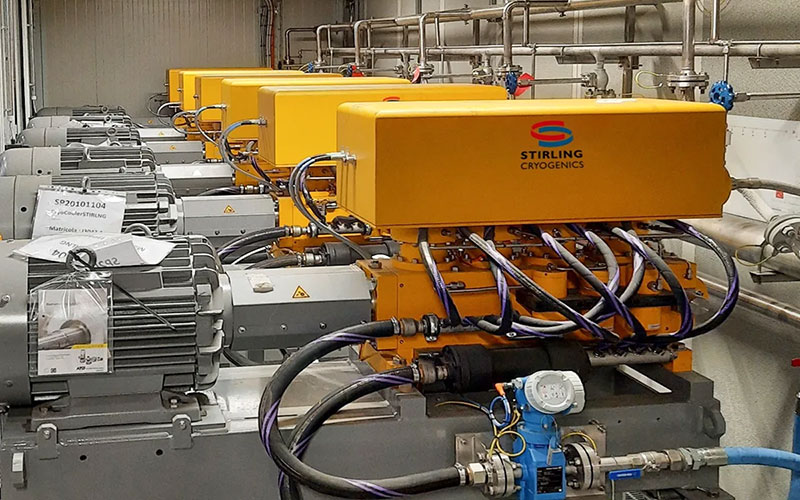



Stirling Zero Boil-off Re-liquefaction Systems
-
- The range of capacities we offer is from 12 up to 350 kg/day in one system, large capacities by multiple systems
- Smaller systems up to 100 kg/day can be placed in a plant room, but can also be offered as containerized system
- Larger systems are offered containerized as standard
- To allow for future growth, systems can be supplied for current size but already built for future extension, allowing later addition of Cryogenerators and hence capacity extension
- Cryogenerators can be stopped and started regularly, allowing to stop part of them in case less GH2 boil-off is generated With increasing GH2 boil-off, more Cryogenerators are started.
- Cool-down time to liquefaction from warm start is 20 minutes, shorter after short stops
- In smaller systems, liquefaction capacity can be varied by rpm depending GH2 boil-of
Liquid nitrogen production systems
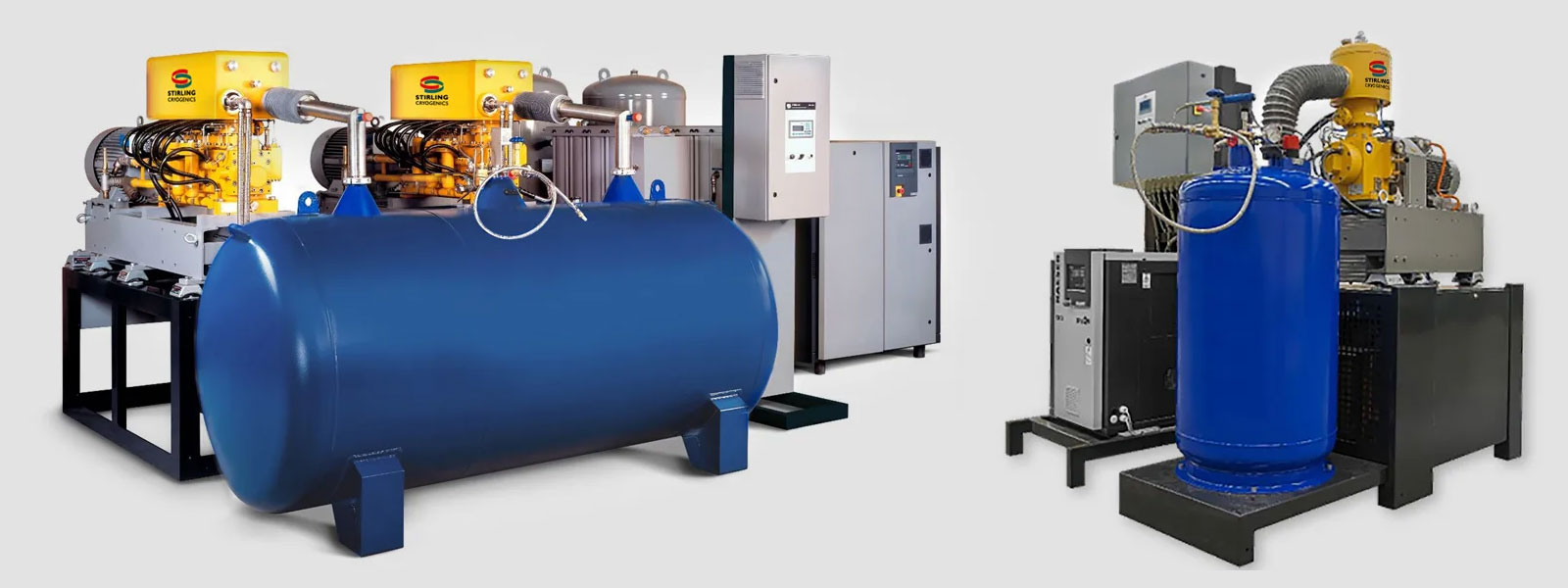
-
Under the brandname StirLIN, Stirling Cryogenics offers a range of liquid nitrogen producing plants with different capacities but all based on the same principle and with the same features.
These StirLIN plants produce LN2 on-site from ambient air by only using electrical power as input and range from 3 up to 50 liter per hour (70 – 3,600 liter per day).
The StirLIN Systems are a popular, plug and produce solution. Taking up little space and ready for work. With the optional chiller no external cooling water supply is needed. Simply connect power and start producing your own liquid nitrogen. The liquid is dispensed through a flexible hose simply by opening a valve. Liquid nitrogen where you need it, when you need it!
Operators only need to replace filters and perform routine checks between maintenance intervals of 8.000 operating hours.
Typical StirLIN features
- Easy Installation
- Fully automatic operation by PLC
- Easy liquid nitrogen dispense
- Efficient production
- Low noise level
- Built for stringent climatic conditions
- Connectable to all power supplies
- Worldwide service & maintenance

StirLIN family

StirLITE, StirLIN-1 Economy & StirLIN-1

StirLIN 1 and StirLIN 2
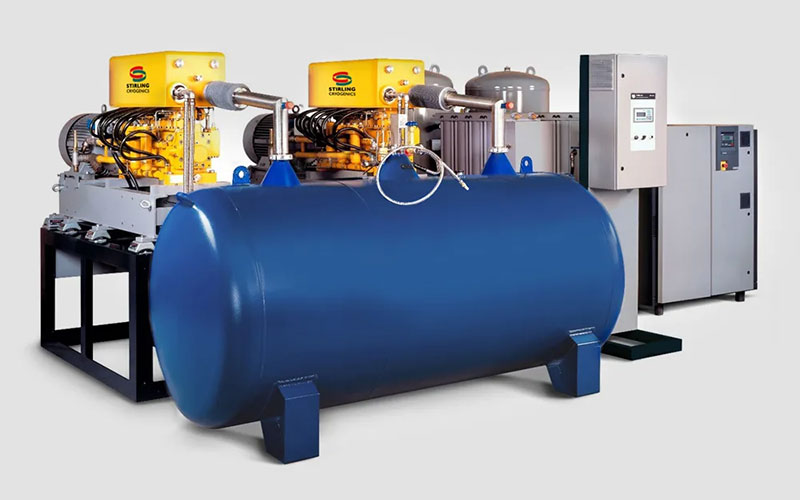
StirLIN 4 and StirLIN 8
Service

-
Stirling Cryogenerators and systems are designed for a long life. Due to the robust design, some of our customers have been able to operate the Stirling Cryogenerator for more than 40 years.
Stirling applies a service philosophy with the following key elements:
- Low operator attention required The operators’ activities are limited to a daily routine check, regular cleaning/replacement of filters and simple compressor oil changes.
- Low maintenance required The Stirling Cryogenerator requires an annual inspection and cleaning. Once every 35,000 operating hours maintenance is required which includes preventive replacement of some parts.
- On-site maintenance Maintenance the Stirling Cryogenerator can be done on-site. There is no requirement of shipping components back to the factory for maintenance or repair, meaning less down-time and transport costs.
- 10 Years supply of spare parts guaranteed Stirling Cryogenics guarantees the supply of spare parts for a period of 10 years after shipment of a system.
- Service engineer availability as local as possible In order to shorten response times to service requests and to avoid high (travel) costs, Stirling aims at availing Service as local as possible. This is achieved by Stirling’s worldwide Service Network. There are also possibilities for customers’ service engineers to be trained by Stirling.
- Remote Service Support Stirling offers the possibility to remotely support the customer in case of operational and maintenance issues.
- Remote control Stirling cryogenerators are equipped with a device that enables remote control of the Stirling system. This has proven to be a very useful tool in case of remote service support.
- Full Service Contracts Under certain conditions Stirling offers the possibility for a full service contract.
References

VAFABMiljo, Sweden - LNG production plants
-
VAFABMiljö operates a waste treatment facility just outside the town of Vasteras in Central Sweden. The company treats municipal waste in an Anaerobic Digester and therewith produces biogas. For some years the biogas with 52% Methane is upgraded to biomethane with approximately 98% biomethane to make it suitable for Compressed Natural Gas (CNG) which can be used for fueling garbage trucks and the town buses.
Some of the buses are converted to use Liquefied Natural Gas (LNG) instead of CNG because their range in km with CNG proved to be too limited. Stirling designed an integrated gas polishing & liquefaction plant for VAFABMiljö capable of delivering 2 ton/day of bioLNG. The plant was commissioned in June 2022.

Conrad Orange Shipyard, Jacksonville USA - LNG BOG
-
Conrad Orange Shipyard, Inc. TX, USA is building the first dedicated LNG bunker barge for the marine market in North America. This barge will be a critical supply chain component in ongoing efforts around the world to reduce the environmental impact of maritime activity through the conversion of ships to LNG.
The barge will operate out of Jacksonville, Florida to serve TOTE’s (parent company to Totem Ocean) newbuild “Marlin class” container vessels and other LNG-powered vessels in the Port of Jacksonville.
The 2,200 cubic meter (cbm) barge is expected to be delivered in early 2017. The LNG barge will feature one tank equipped with MARK III Flex cargo containment technology, from the French engineering and technology company GTT (Gaztransport & Technigaz) and is constructed by Conrad Orange Shipyard under GTT license. Bristol Harbor Group, Inc. is responsible for the vessel’s design, with the American Bureau for Shipping (ABS) acting as the classification society.

